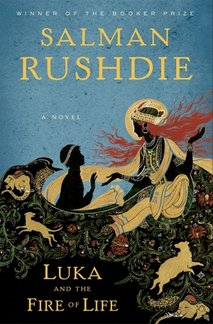
18 Nov 2010 03:43:16
"Luka and the Fire of Life," Rushdie's fable of an adored son returning his parents' devotion and maturing a bit along the way, reads as a video game might if the video game were a novella. There are sequential challenges, a beautiful female chaperone (who not-so-mysteriously shares the first name of Luka's mother) and a series of "levels" Luka must attain before he loses so many "lives" that he is disqualified.
But the serious undercurrents are many and thought-provoking.
Luka is led away from his ailing father's bedside by a frightening, see-through doppelganger for his beloved storytelling dad. (The father also figures prominently in Luka's older brother's quest, as told in "Haroun and the Sea of Stories," to which this is a sort of companion volume, not a sequel.)
The apparition calls himself Nobodaddy. Speaking in parables and riddles and unveiled threats, he offers Luka two grim options: The boy can either undertake an arduous journey that no one before has survived to steal the Fire of Life and bring it home, or he can watch his father wither and die as Nobodaddy gains texture and vitality. Luka quickly signs on to rescue his father's spirit.
Nobodaddy makes clear at the start of Luka's fantastical journey that true power lies in understanding the strength of stories and imagination and in thinking independently and creatively.
"You of all boys should know that Man is the Storytelling Animal, and that in stories are his identity, his meaning, and his lifeblood," Nobodaddy lectures. "Do rats tell tales? Do porpoises have narrative purposes? Do elephants elephantisize? You know as well as I do that they do not. Man alone burns with books."
Acting ultimately as Rushdie's own spokesman, of course, Nobodaddy piles on many more heavy truths, often in funny and endearing ways. The 13-year-old we consulted said "Luka" would be best read aloud, either to or by kids ages 8 to 11 or so.
But the serious undercurrents are many and thought-provoking.
Luka is led away from his ailing father's bedside by a frightening, see-through doppelganger for his beloved storytelling dad. (The father also figures prominently in Luka's older brother's quest, as told in "Haroun and the Sea of Stories," to which this is a sort of companion volume, not a sequel.)
The apparition calls himself Nobodaddy. Speaking in parables and riddles and unveiled threats, he offers Luka two grim options: The boy can either undertake an arduous journey that no one before has survived to steal the Fire of Life and bring it home, or he can watch his father wither and die as Nobodaddy gains texture and vitality. Luka quickly signs on to rescue his father's spirit.
Nobodaddy makes clear at the start of Luka's fantastical journey that true power lies in understanding the strength of stories and imagination and in thinking independently and creatively.
"You of all boys should know that Man is the Storytelling Animal, and that in stories are his identity, his meaning, and his lifeblood," Nobodaddy lectures. "Do rats tell tales? Do porpoises have narrative purposes? Do elephants elephantisize? You know as well as I do that they do not. Man alone burns with books."
Acting ultimately as Rushdie's own spokesman, of course, Nobodaddy piles on many more heavy truths, often in funny and endearing ways. The 13-year-old we consulted said "Luka" would be best read aloud, either to or by kids ages 8 to 11 or so.

